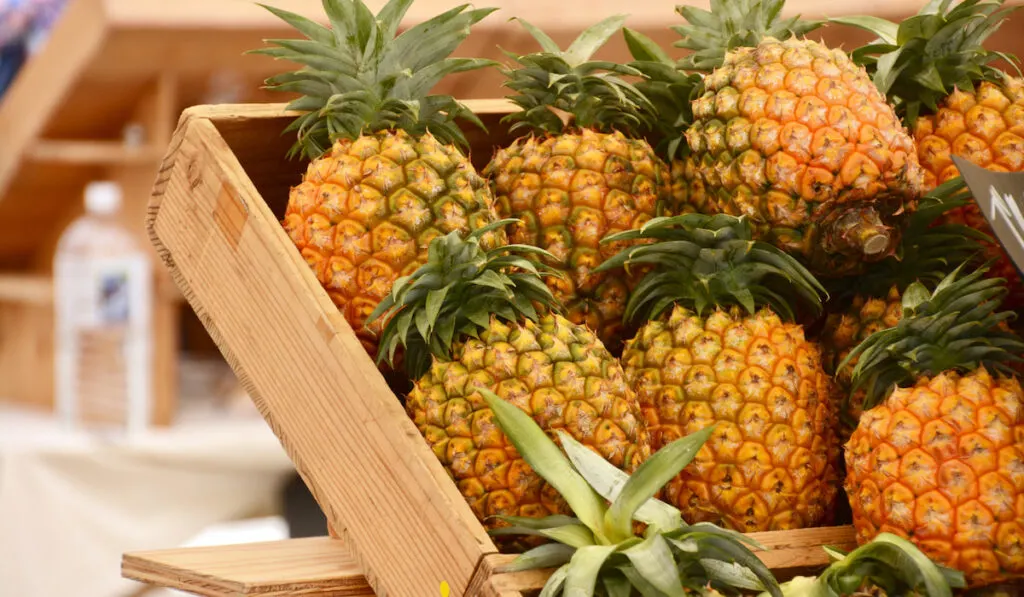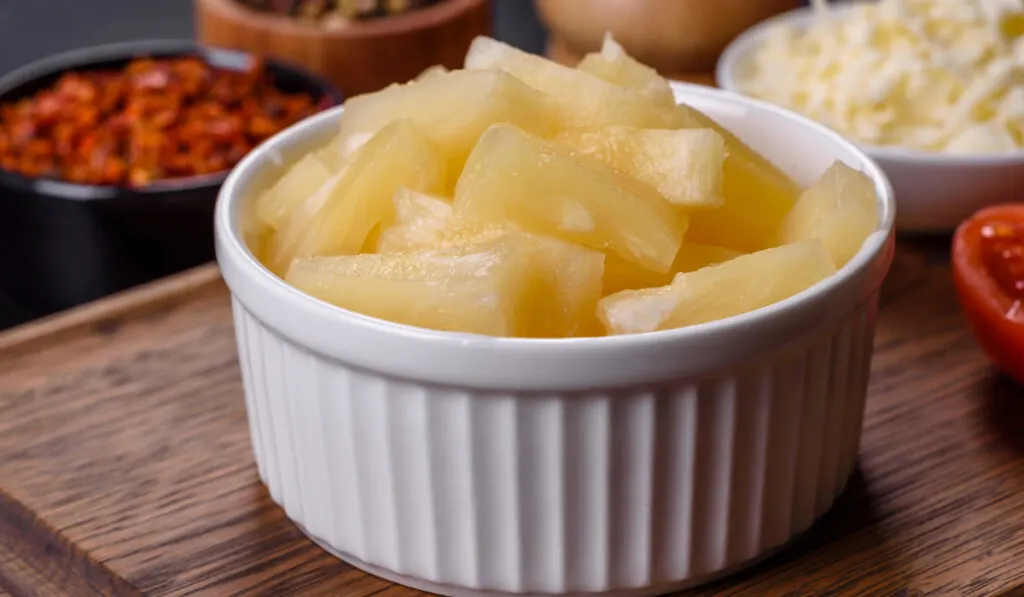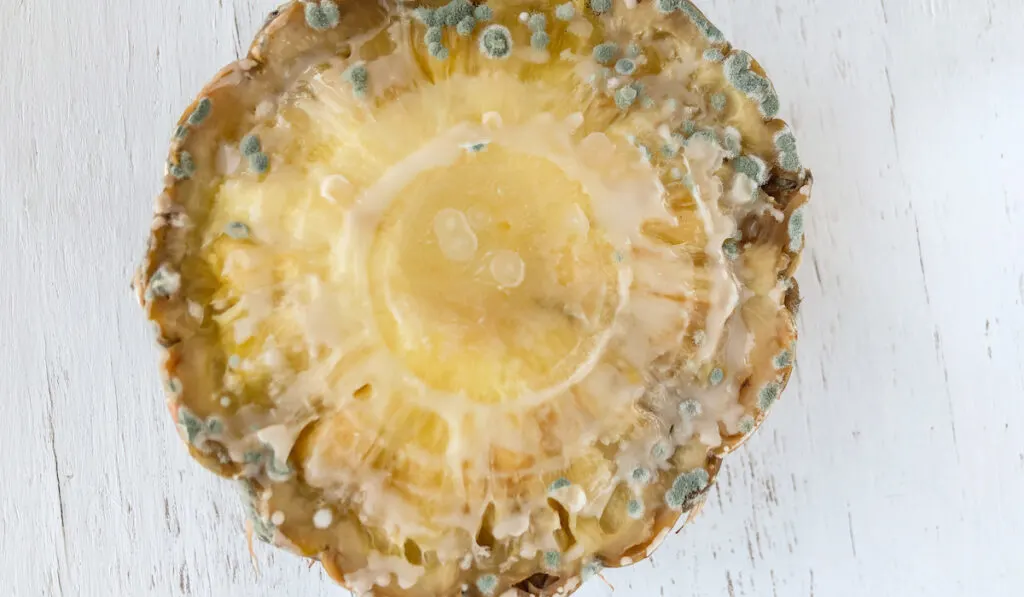Pineapples are sweet, juicy, tropical fruits that are full of nutrients and vitamin content. With their fresh, sweet, and delicious taste, pineapples are great to eat raw or to prepare in various ways with countless meals and desserts.
Once harvested, pineapples become perishable. It is essential to know how to safely store them to preserve their freshness and to know how to tell if pineapples have simply turned bad so you can enjoy these refreshing fruits in a multitude of ways.

Table of Contents
How Long Do Pineapples Last?
Pineapples have a short shelf life because of their high liquid content. Therefore, proper storage and practicing food safety techniques help preserve their freshness.
Whole Pineapple
Whole, fresh and uncut pineapples last for 2 to 3 days on the counter at room temperature and will start their rotting process soon afterward.
Whole pineapples last longer in the refrigerator and can extend their shelf life up to 4 to 5 days.
Pineapples bruise easily so avoid putting anything on top of them when they are in the refrigerator. It is not recommended to freeze a whole pineapple for practical reasons. Because of its large, oval shape, a pineapple would take up a lot of space in the freezer.
Whole pineapples also take a while to freeze and do not last long once you thaw them so placing whole pineapples in the freezer is not favorable.
Pineapple Chunks or Slices
You can consume pineapple chunks or slices in about 1 to 2 hours at room temperature. If you cannot consume all of it, you have the option to cut the pineapples into chunks or slices and refrigerate the remainder to preserve their freshness.
They last for 3 to 4 days in the refrigerator before they turn brown and start their deteriorating process. The pineapple should be placed in an airtight container.
If using a plastic bag to store your pineapple, squeeze out as much air as possible from the plastic bag.
You can prolong its shelf life even more by putting some simple syrup on the pineapples placed in the container.
To prevent sliced pineapples from turning brown, you can also squirt citrus juice all over the pineapple chunks. Pineapples can be frozen if sliced and peeled into smaller portions and stored in a covered container or resealable plastic bag.
Frozen pineapple chunks or slices last up to 3 to 5 months in the freezer. Although you have to take into consideration that its quality and flavor will decline over time.

Can You Eat Overripe Pineapples?
Overripe pineapples are still good to eat and won’t make you sick. Overripe pineapples are safe to consume and cook.
Although if your overripe pineapple tastes funny or different, it is best to just throw it out.
If it tastes normal, you can still eat it raw, make fresh pineapple juice, or include it in a dessert. When pineapple goes beyond overripe, it starts to ferment and rot and these should be discarded.
Overripe pineapples usually have drooping and dried leaves and their flesh is somewhat soft and has a few brown spots. These kinds of overripe pineapples are still edible.
But if you see that the flesh of the pineapples is mostly browned out or that the brown areas have whitish dots, it means that the mold is beginning to grow and they should be discarded.
You can eat overripe pineapples but when you spot signs of rotting, throw them away immediately.
How to Tell If a Pineapple Is Bad?
It is important to be able to examine the quality and freshness of pineapple and to determine whether your pineapples are ripe, overripe, or rotten.
Here are seven common signs to tell if a pineapple is bad and should be thrown away.
1. Color
You will know if the pineapples are ripe, overripe, or rotten by examining the physical exterior of the pineapples.
Fresh and ripe pineapples are greenish-yellow in color, the more yellow it is the more ripe the pineapples are.
Pineapples turning bad will turn a darker gold, orange, or brown in color and its body will appear old, withered, and dried out. If the surface has an orange color and brownish flesh, this indicates that the pineapples are rotting already.
2. Foul Smell
Pineapples usually have a sweet and tangy smell when they are fresh.
When pineapples become spoiled, they give off a strong, sour smell as the fruit begins to ferment.
A fermented aroma that has a pungent smell of alcohol or vinegar needs to be avoided.
3. Browning and Wilting Leaves
Fresh pineapples have green, healthy, vibrant leaves.
The first signs of aging in pineapples are the leaves drying out, losing their color, or turning brown or grayish on the crown.
When the leaves are wilting and falling out or you are able to remove them without force, it means that the pineapples are rotten.
4. Texture
Check the texture of the pineapples, especially at the bottom.
If the bottom is soft, wet, or has white patches, these are clear signs that the pineapple is bad.
The bottom of the pineapples is the first to show signs of deterioration of the fruit.
Fresh and ripe pineapples should be firm so check the texture of the surface. If they are soft and spongy with a watery texture, that means the pineapples are starting to rot.
5. Mold

Look for signs of mold on the leaves and surface of the pineapples. If the pineapples develop white spots and mold growing on the surface, they should be thrown away.
If you see white spots on a cut or sliced pineapple, these are indicators of fungi growth and the fruit should be discarded immediately.
6. Brown and Mushy Flesh
If you can’t figure out if the pineapples are good or bad from the outside, one way to check it is to slice it.
The flesh of ripe pineapples should be yellow and fresh.
If the flesh of the pineapple is brown and mushy, then the pineapple is rotten.
If there are only a few brown spots that don’t go deep into the flesh, you may be able to cut out those bits and eat the rest of the pineapple.
But if the brown areas have white spots, these are bacteria growing on the flesh and it should not be eaten.
7. Bitter Taste
Fresh and ripe pineapples should be sweet and tangy.
If the pineapples taste pungent or bitter, avoid eating them as they may be spoiled.
Ripe and fresh pineapples are the best to consume with their sweet and mouthwatering taste. Don’t let them sit in the pantry for too long as these fruits tend to go bad quickly.
Enjoy pineapple for a delicious and healthy snack. 🍍
